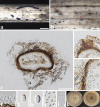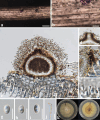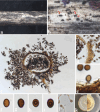Multigene phylogeny, taxonomy, and potential biological properties of Pseudoroussoella and Neoroussoella species (Roussoellaceae, Dothideomycetes) from Asteraceae weeds in northern Thailand
- PMID: 39723168
- PMCID: PMC11669009
- DOI: 10.3897/mycokeys.111.136922
Multigene phylogeny, taxonomy, and potential biological properties of Pseudoroussoella and Neoroussoella species (Roussoellaceae, Dothideomycetes) from Asteraceae weeds in northern Thailand
Abstract
In our study, dead stems of two Asteraceae species (weeds) were collected from northern Thailand. Both morphology and multigene phylogeny were used to determine the identity of the taxa. Maximum likelihood and Bayesian inference analyses of combined LSU, SSU, ITS, tef1-α and rpb2 data revealed two new species Pseudoroussoellabidenticola, and Neoroussoellachromolaenae with one new host record of N.entadae. Preliminary investigation into antibacterial properties revealed that our three isolates inhibited the growth of Bacillussubtilis, Escherichiacoli, and Staphylococcusaureus. Additionally, we present updated phylogenetic trees for Roussoellaceae, accompanied by detailed descriptions and illustrations of the three identified species.
Keywords: 2 new species; Ascomycota; Bidenspilosa; Chromolaenaodorata; antibacterial properties; new host record.
Zin Hnin Htet, Kevin D. Hyde, Fatimah O. Alotibi, Thilini K. W. Chethana, Ausana Mapook.
Conflict of interest statement
The authors have declared that no competing interests exist.
Figures




Similar articles
-
Bambusicolous Fungi in Pleosporales: Introducing Four Novel Taxa and a New Habitat Record for Anastomitrabeculia didymospora.J Fungi (Basel). 2022 Jun 13;8(6):630. doi: 10.3390/jof8060630. J Fungi (Basel). 2022. PMID: 35736113 Free PMC article.
-
Three novel species and a new record of Pleosporales (Didymellaceae, Roussoellaceae) from China.MycoKeys. 2025 Feb 12;113:295-320. doi: 10.3897/mycokeys.113.139934. eCollection 2025. MycoKeys. 2025. PMID: 39980720 Free PMC article.
-
Four new species of Dothideomycetes (Ascomycota) from Pará Rubber (Heveabrasiliensis) in Yunnan Province, China.MycoKeys. 2024 Mar 22;103:71-95. doi: 10.3897/mycokeys.103.117580. eCollection 2024. MycoKeys. 2024. PMID: 38560534 Free PMC article.
-
Multigene phylogeny and taxonomy of Dendryphion hydei and Torula hydei spp. nov. from herbaceous litter in northern Thailand.PLoS One. 2020 Feb 5;15(2):e0228067. doi: 10.1371/journal.pone.0228067. eCollection 2020. PLoS One. 2020. PMID: 32023268 Free PMC article.
-
Paramyrothecium eichhorniae sp. nov., Causing Leaf Blight Disease of Water Hyacinth from Thailand.Mycobiology. 2022 Feb 24;50(1):12-19. doi: 10.1080/12298093.2022.2027683. eCollection 2022. Mycobiology. 2022. PMID: 35291591 Free PMC article. Review.
References
-
- Chaiwan N, Gomdola D, Wang S, Monkai J, Tibpromma S, Doilom M, Wanasinghe DN, Mortimer PE, Lumyong S, Hyde KD. (2021) An online database providing updated information of microfungi in the Greater Mekong Subregion. Mycosphere 12(1): 1513–1526. 10.5943/mycosphere/12/1/19 - DOI
LinkOut - more resources
Full Text Sources
